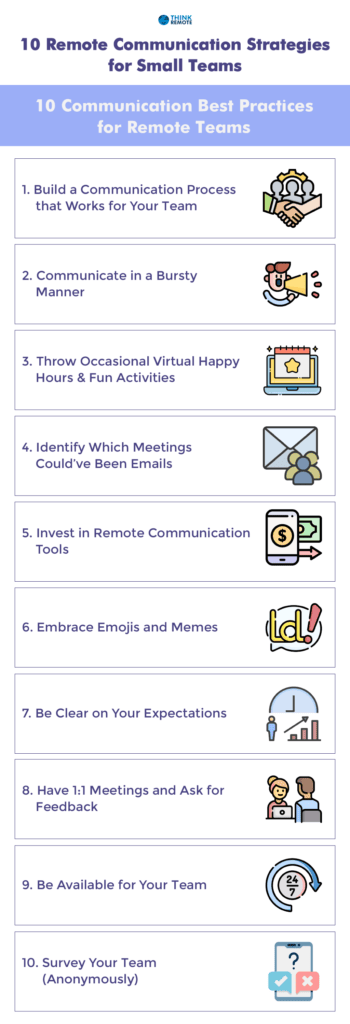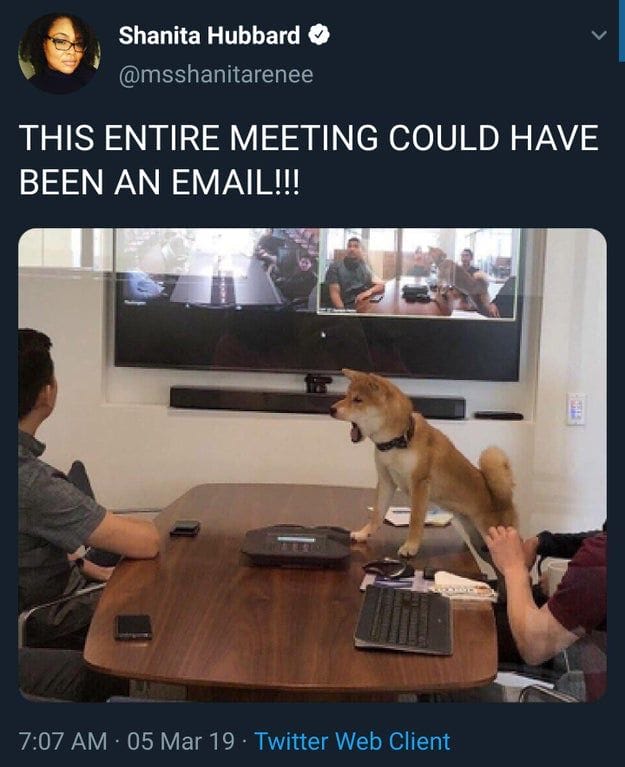Some people love chocolate mint ice cream; others think it tastes like toothpaste (Shocking, right?!). Some people believe pineapple pizza is the best human invention; others can’t even smell it. Similar to food preferences, remote teams are diverse. What works successfully for big teams might not work for small teams. Especially when it comes to remote team communication strategies, the lines get blurred.
10 Communication Best Practices for Remote Teams
Establishing the right communication channels, tools, and strategies in remote teams is not about copying what others are doing. But it’s about knowing what will work best for you.
Here are some of the best practices that will serve you as guidelines to establish the best remote communication methods.

1. Build a Communication Process that Works for Your Team
Every remote team is different. Implementing the best remote communication team strategies will depend on how well you know your team. And this is something that is learned through trial and error.
Especially if you’re starting to build your remote team, you’ll probably want to mimic what other successful companies have done. This means virtual water coolers, happy hours, video call meetings, and so on. However, maybe these strategies don’t work with your team.
Start by identifying those that do work and build your communication process. Learn what tools work best, what type of meetings are more productive, and document it.
Also, during this documentation process, something to keep in mind is time zones. If your team members are spread across the world, make sure the document has everyone’s availability hours. This makes it easier to reach out to other members, and overall, to schedule meetings and activities.
2. Communicate in a Bursty Manner
According to Harvard Business Review, communicating in a bursty manner makes remote teams more effective.
But what does “bursty manner” even mean?
Human communication mixes periods of high activity with periods of little to none. Harvard’s research suggests that those bursts of rapid-fire communications, with longer periods of silence in between, are what makes teams more focused and productive.
During the silent periods, team members do their deep work, focusing on specific tasks and projects. But, when these communication bursts happen, team members have more energy to develop ideas, work collaboratively, and brainstorm.
So, how to implement this on your small remote team? Instead of embracing the async philosophy, where communication is primarily by email and texting whenever team members feel like it, make communication more organized.
Define with your team members work routines, where everyone will be focused on doing their deep work during certain hours, but during other hours they will be available for these rapid-fire messages and meetings.
This schedule doesn’t have to be extremely structured, especially when teams live in different time zones. It’s just about coordinating with your team and figuring out what times work best for everyone.
3. Throw Occasional Virtual Happy Hours & Fun Activities
Work is not only about work. There’s always time to bond, connect, and have a great time.
However, the key to making these activities work relies on the word “occasional.”
When remote work became a reality for most teams, remote managers had the need to prioritize their team’s psychological safety and looked for ways to connect with them. While this is great, it also became frustrating for employees to attend every Friday’s virtual happy hour.
Instead of making these events often, why not make them occasionally? That way, you get to connect with everyone more personally without making them feel forced to attend.
Here are some ideas of virtual activities to make:
- Happy hours
- Virtual coffee
- Scavenger hunt
- Seasonal events (Like Halloween or Valentine’s Day celebration)
- Wine tasting
- Gaming night (Trivia, I spy, Bingo, etc.)
Also, a great way to connect with your team occasionally is by celebrating wins! When you finished a project successfully, got a new client that was challenging to convince, or any other challenge you overcame, showing gratitude towards your remote team is a great way to build stronger relationships.
4. Identify Which Meetings Could’ve Been Emails

We’ve all experienced the famous “Zoom fatigue.” While in remote teams, we sometimes miss connecting and talking with our colleagues; other times, we just want to work to finish on time. And constant video call meetings make this harder.
During the start of the pandemic, almost every remote work “guru” mentioned how video calls were fundamental. And although they are important, they don’t need to take place every day at every hour.
Identify which meetings need to take place and which ones can happen via email, Slack, voice messages, etc. Otherwise, your team will feel drained constantly, and it will be harder for everyone to be productive.
Understanding what communication channels work best and why will help you increase the productivity and motivation of your team.
5. Invest in Remote Communication Tools
When you manage a small remote team, investing in communication tools might seem unnecessary. Mostly because you can easily talk with everyone by WhatsApp or via email, so why bother?
While the basic communication tools work, the point is not in having strategies that just work. You want your team to be as productive and efficient as they can be, and this won’t happen unless you give them the tools to do so.
One of your remote team communication strategies needs to be investing in the right tools. This will help you organize things better, document, and keep track of projects and tasks.
These are some of the best communication tools for remote teams:
- Slack: For many remote teams, Slack is used as the virtual HQ. It’s one of the best communication tools for online messaging, file-sharing, and creating channels to organize workgroups. It integrates with other tools like Zoom, Github, and Google Drive.
- Zoom: The most popular video conferencing platform. It’s the perfect tool to hold virtual meetings, as it has screen sharing and call recording features. Zoom also can hold conferences and webinars.
- Basecamp 3: Basecamp is a project management tool. It helps teams organize projects, tasks, deadlines, and overall communication. It’s suitable for small remote teams. Among its features, you’ll find task management, task and messaging, file sharing, and document tracking.
- Trello: Another project management tool that works under the Kanban methodology. It’s great for small businesses, as projects can easily be created in card templates, and it shows visually how each project is going, who is in charge, what tasks are being taken care of, etc.
- Google Drive: Everything is in the cloud now! Remote teams need a place to keep their documents safe, and Google Drive is the perfect app for this. Employees can access files at any time, regardless of their location.
Check out this article for more tools and apps to work from home successfully.
Bonus tool: WorldTimeBuddy – It’s a great tool that works as a time converter for remote teams. You can easily know the time zones differences with all your team members.
6. Embrace Emojis and Memes

One of the disadvantages of communication in remote teams is you don’t know the tone of the messages. It’s easier to take things personally and have misunderstandings with employees because they are not seeing your face or sensing the tone of your message.
The good news is that emojis and memes are the perfect strategies to lighten up the environment. A study conducted by Emogi found out that people use emojis because it helps them be better understood and create personal connections.
Working with remote teams is also learning how to bond and connect with them. While the idea is not to flood Slack or email with work-from-home memes, an occasional one can make everyone laugh and simply have a good time.
7. Be Clear on Your Expectations
Remember that time that a project didn’t go out as you expected? You had meetings and discussions planning it, but employees didn’t fulfill the deadlines, and overall, everything was messy.
Instead of pointing out someone as guilty, next time, make sure to set clear expectations. In other words, over-communicate.
Your team members might think they are giving their everything, but if they didn’t fully understand what you want, it wouldn’t be enough even if they pour their soul and hear out. And the last thing you want to do is burn them out.
So, every time you have new projects and tasks to delegate, make sure to provide clear expectations, measurable goals, and specific deadlines. That way, everyone knows what they have to do.
8. Have 1:1 Meetings and Ask for Feedback
One-on-one meetings are the perfect space to check out your employees’ well-being. For most leaders, this is one of the most effective remote team communication strategies as it helps them get to know their employees better and see in what ways they can help them.
Especially in the pandemic, many people lost their loved ones or had difficult situations. As a manager, you can take a few minutes of your day and call your employees to have a short conversation. Ask them how they are doing, their workload, or if they need any help. One-on-ones will make them feel valued and supported.
And if an employee has had a great performance, why not motivate them with a simple “You’re doing a great job, keep going”. While gifts and celebrations are always a great idea, leaders tend to forget the power of words. A simple “thank you” can lighten up someone’s day.
9. Be Available for Your Team
The famous quote “actions speak louder than words” is the perfect example of this. There’s no point in saying to your team you’ll always be there for them if they need help, or if they’re facing an obstacle if whenever they text you, you never answer.
Showing reliability is about aligning your words with your actions. These are some ways to show you´re there for your team:
- Dedicate time for personal check-ins (One-on-ones)
- Trust your team – don´t micromanage
- Allow employees to schedule appointments with you on your calendar
- Ask for their opinion in meetings
10. Survey Your Team (Anonymously)
An Anonymous survey is a great way to find out what your team really thinks about you and overall the organization.
For some employees, although they might have the best intentions, it is hard to speak up. In some cases, due to their previous experiences, they feel that speaking out will get them in trouble.
But, if they have the space to do it anonymously, they won’t be afraid of speaking their minds. You can create general surveys or specific ones depending on your needs. For example, if you want to know how the team feels about your management, or if you want to know how employees feel about communication on the team or project management.
Keep in mind that anonymous surveys are great to have a general idea of how things are going in certain areas. But if you want to follow up or get more details, you could consider doing a confidential survey.
These are some great platforms to run surveys:
- SoGoSurvey
- SurveyMonkey
- Typeform
Build a Solid Remote Team with the Right Communication Strategies
The key to building a successful remote team is establishing communication processes and tools right from the start. Remember, there´s no one-size-fits-all approach here. You need to understand your team´s dynamics and identify the best tools and processes.
With these 10 strategies, you can start experiencing the best ways to communicate, build relationships, and create a healthy remote work environment.






